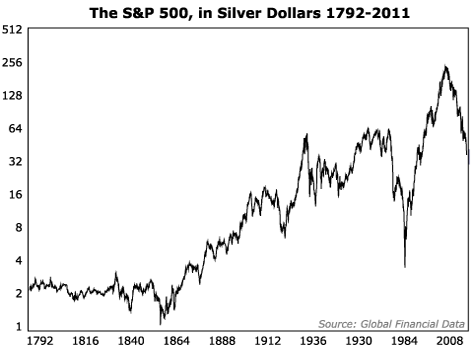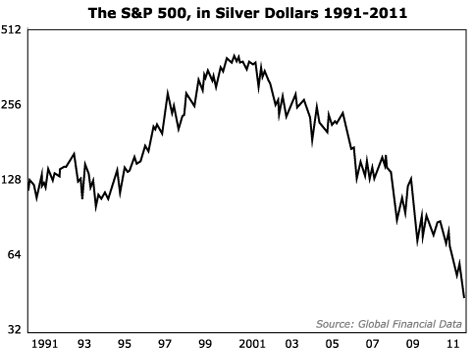| Home | About Us | Resources | Archive | Free Reports | Market Window |
A Precious Metals Chart the Government Won't Ever Show YouBy
Tuesday, April 19, 2011
Over the past two years, I've been telling my readers about the sham the U.S. government is perpetuating on its citizens. I've shown you what corrupted the American system, why our debt problem is worse than you know, and how to protect your family from what I'm calling the End of America.
If you're not convinced yet... there's probably not much I can do. But I'd like one more chance. In today's essay, I lay out one more way to look at the problem. See if you don't finally take action.
(If you are already convinced – and are already doing everything you can to protect yourself – pass this around to your friends. If you care about their financial wellbeing, they need to see it, too.)
First, though, we need to back up...
At one time in American history, the benefits of sound money and the risks of easy credit were completely understood. It was during the founding of our country... just after the Constitution was ratified.
The Second Congress of the United States passed the Coinage Act of 1792. The act established the dollar as the currency of the United States and defined precisely what a dollar was: 24.1 grams of pure silver.
To ensure the quality of America's money, three coins were taken from every major batch minted. Each year on the last Monday in July, the chief justice of the Supreme Court, the secretary of the Treasury, the secretary of State, and the attorney general witnessed these coins being assayed.
If the sample coins did not meet legal standards, the officers of the mint would be dismissed and the $10,000 surety bonds they posted would be seized. Further, if any officer of the mint was found guilty of embezzlement or of debasing the coins, the penalty was death.
Compare that system – where the most senior members of the federal government are in charge of maintaining the soundness of our money – with today's system. Under the current system, the federal government has become the biggest counterfeiter in the world.
Fed Chairman Ben Bernanke has tripled the monetary base of the United States in only two years. The dollar lost 50% of its purchasing power under Alan Greenspan. And since the dollar was taken off of the gold standard in 1971, it's lost 90% of its purchasing power.
But what does the outrageous perfidy of our political class mean to you? Let me show you...
Imagine if the dollar was still defined as 24.1 grams of pure silver. (That's the exact amount of silver in the famous "Morgan dollar.") Imagine if companies paid dividends to shareholders in silver coins (or a mixture of gold and silver coins). Imagine when you saw the S&P 500 quoted in dollars, those dollars represented amounts of silver, not empty promises from the Federal Reserve. What would our stock exchange look like if our money was still "real"?
This chart shows the value of the biggest U.S. corporations, as measured by real silver dollars, since the founding of our country.
 You can see a long and powerful uptrend that begins just after the Civil War and continues until the late 1960s.
That's when the trouble starts...
In the late 1950s and early 1960s, the U.S. economy began running a constant and growing deficit with the rest of the world. Borrowing – mainly in the public sector – fueled these deficits, as the government tried to expand its social spending and fight a foreign war without raising taxes. Facing the possible loss of all its gold reserves, sharply higher borrowing costs, or both... the U.S. simply repudiated these debts, abandoning the pledge we'd made at Bretton Woods in 1946 to always allow foreign central banks to exchange their dollars for gold.
We cheated our creditors, rather than repay our debts.
The value of the U.S. dollar collapsed as a result. The loss was so severe that during the 1970s, the "real" value of the S&P 500 – as measured in silver – fell by almost 90%. Of course, since most people didn't look at the world through the lens of real money, few realized what was happening.
In terms of paper dollars, stocks ended the 1970s about where they began. But in terms of purchasing power – in terms of real money – stocks would not regain their 1960s highs for 27 years.
By using paper money instead of silver, politicians discovered they could easily hide declines in America's standard of living and our national wealth. In short, they discovered it was easier to "paper" over our problems than allow failing institutions and businesses to go under. It was easier to cheat our creditors than pay our debts.
On the other hand, sound monetary policy (thanks to Paul Volcker) drove the big bull market of the 1980s and 1990s. But toward the end of the 1990s, debts began to explode again relative to the size of our economy. This second credit bubble, fostered by Alan Greenspan, wasn't limited to the public sector. Private debts soared, too... especially credit card, mortgage, and student-loan debt.
These policies sparked another huge devaluation of the dollar, one that has continued almost unabated today. That's why, in terms of silver, the value of the S&P 500 has been in a steady bear market since 2000. Take a look...
 The supposed recovery we saw from 2003 to 2008 never shows up on this chart. It was all financed with funny money – debts the market knew would never be repaid.
What's the end game? How will our country (and most of the developed world) learn to live within its means? We continue to believe the most likely answer is "painfully." There just aren't many happy endings for countries with this much debt or with corrupt political systems that wield so much power.
And so... despite the high prices of gold and silver, we continue to urge investors to buy precious metals until they constitute at least 10% of their portfolio. Good investing,
Porter
Further Reading:
If you've already moved a prudent percentage of your net worth out of paper dollars, you're way ahead of the crowd. If not, please know it's not too late. We recommend you review Porter's arguments below. We know you'll walk away with a lot to think about...
"Or as our friend Rick Rule likes to say, paper money's track record is unblemished by success. The return of paper money to its intrinsic value (nothing) is guaranteed."
"We are not going to have a crisis. We are in a crisis right now. And now is the best time to hedge your portfolio... before the rest of the world realizes a massive inflation is underway."
"We created this economic tragedy over the last 40 years by abandoning... willingly, our core economic advantages. Our leaders convinced us these things didn't really matter... and we could succeed without them. They will be proven wrong."
Market NotesA VITAL MARKET SECTOR IS STILL STRUGGLING Now that stocks have met selling pressure at the "test" level of 1,343, it's important to note the poor action in the big financial fund, XLF.
Longtime DailyWealth readers know we keep an eye on the XLF because it's a large, diversified way to take a position in American financial stocks. Major weightings in the fund include Wells Fargo, Bank of America, Citigroup, and JPMorgan. These are the companies that rise and fall with America's ability to earn money, pay off debts, start new businesses, and just generally "get along."
From late 2009 to early 2011, the XLF was "stuck" in a long sideways trading pattern between $14 and $16.50 per share. Several months ago, it broke out to the upside north of $17 per share. But the recent market weakness has sent this fund back into the sideways pattern... and near its 2011 low. Recent earnings reports show these big banks are still hampered by the glutted, constipated housing market.
For better or worse, America is a land of financial leverage... so as long as the likes of Bank of America and JPMorgan are struggling to post profit and share price growth, it's a sign the economy is in no boom. And unless the XLF can finally say goodbye to its long base, it's going to be hard for stocks in general to move higher.
|
In The Daily Crux
Recent Articles
|

